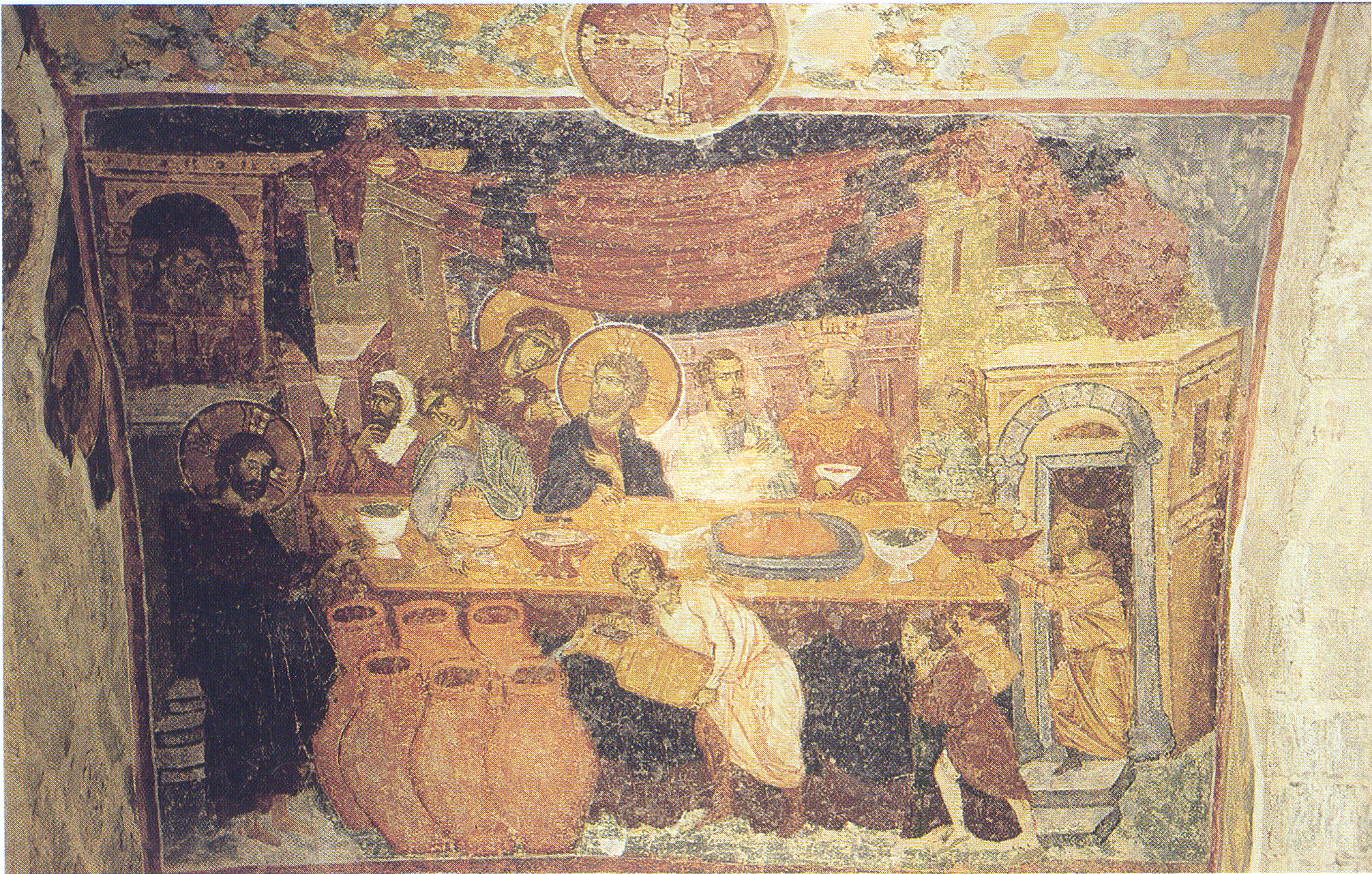Marriage
20 Μαΐου 2009

The Wedding in Cana. Fresco from the Church of St. Sophia in Trebizond (Pontus), ca. 1250-1270. ("Pemptousia" magazine, issue 3, pg. 148)
The family is the basic unit or ‘cell’ of society, and the Christian family is also a major building block of the Orthodox Church. The Church places greet importance on the family to fulfil its role as a small church, as expressed by the Apostle Paul. When St. Paul greeted Priscilla and Aquila, his “fellow workers in Christ Jesus” he also greeted “the church that is in their house” (Romans 16:3, 5). He also greeted “Nymphas and the church that is in his house” (Col 4:15).
Monasticism is also another major Christian social unit. The Church places this unit above married life as monasticism has played an important role as the guiding element in Her history. Monasticism supports the Church, preserves Her dogmas and keeps the Divine Liturgy Orthodox. While the Church blesses the monastic life, She also blesses marriage knowing that not all can take on the responsibility and commitment that comes with celibacy and living a monastic life. This blessing is acknowledged as a Mystery (Sacrament) of the Church.
The Sacrament (Mystery) of Marriage
In the Mystery of Marriage the Church asks God to help the couple being married understand, fulfil and establish a ‘church’ at home, i.e. to establish Christian relationships within the family, to raise children in the faith and life according to the Scriptures, to be an example of humility and patience for your children to follow.
The Christian family begins with the Mystery of Marriage, and specifically with the exchange of rings and placing of the wedding crowns (wreaths) upon those being married. This is accompanied with the words, “The servant of God N____ is married to the servant of God N____ in the name of the Father and of the Son and of the Holy Spirit”, and then, “O Lord our God, crown them with glory and honour”. The rings have a deep symbolic meaning. This symbolism is indicated with the words, from the Service of Betrothal, “Through a ring the authority was given to Joseph in Egypt; through a ring Daniel was glorified in the land of Babylon; through a ring the true identity of Thamar was discovered; through a ring our heavenly Father showed mercy on the prodigal son; for he said, Put a ring on his fingerÉ”. The crowns and their exchange symbolise the couple’s citizenship in the Kingdom of God, where “there is neither male nor female” (Gal. 3:28), and of their dying to each other (c.f. Rev. 2:10).
The Holy Scriptures tell us that God “blessed” marriage from the beginning of time saying “Be fruitful and increase in number; fill the earth” (Gen. 1:27-28), showing that marriage is part of God’s eternal purpose for humanity. Further on, in Genesis 2:24, we read, “Therefore a man will leave his father and mother and be united to his wife, and they will become one flesh”. Our Lord Jesus Christ reiterated these words when asked if it is lawful for a man to divorce his wife. He continued, “So then, they are no longer two but one flesh. Therefore what God has joined together, let not man separate” (Matt. 19:4-6).
Christ forever sanctified marriage by His presence at the marriage in Cana of Galilee (John 2:1-11). This was the first time Christ performed a miracle, and the first time the Theotokos interceded with Christ on behalf of others saying, “They have no wine”, and then instructs all humanity, “Whatever He say to you, do it”.
The Apostle Paul compares the Mystery of Marriage with the Church in these words, recited during the Crowning Service, “Husbands, love your wives, just as Christ also loved the Church and gave Himself for her”, and “for this reason a man shall leave his father and mother and be joined to his wife, and the two shall become one flesh. This is a great mystery, but I speak concerning Christ and the church” (Eph. 5:25, 31-32). In 1 Corinthians 7, St. Paul gives detailed guidance on virginity and marriage. He also commands that marriage should be preserved.
Thus, marriage is holy, blessed and everlasting sacrament in the sight of God and His Church.
Finally, history closes with marriage of the Bride to the Lamb (Rev. 19:7-9), thus fulfilling the earthly marriage in the heavenly, showing the eternal nature of marriage.
Reference – The Orthodox Study Bible, p449
Copyright © 1993 by St. Athanasius Orthodox Academy, Nelson ISBN 0-8407-8391-4



